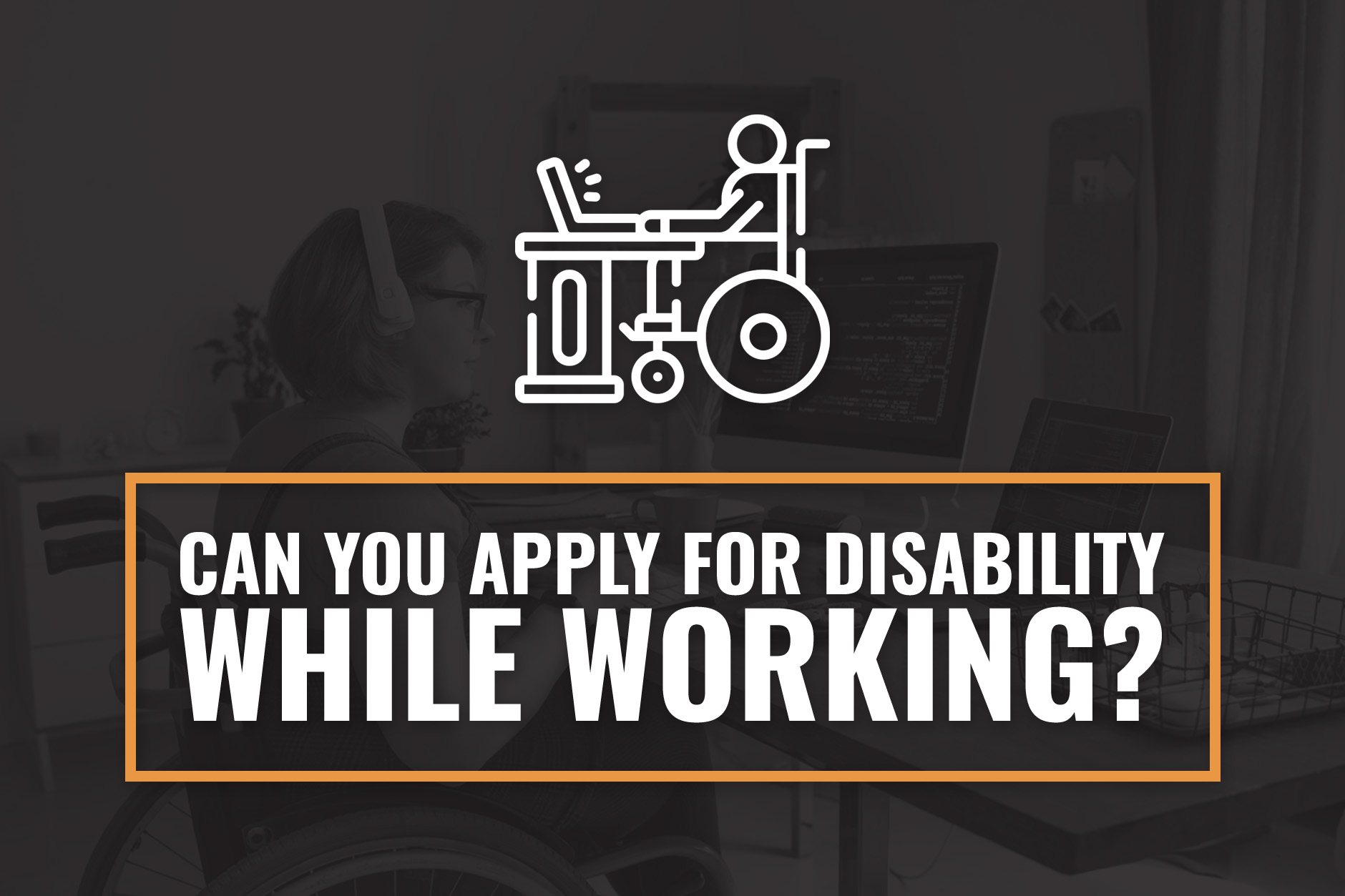
Table of Contents
You’ve been managing a health condition that’s making it harder to keep up with work. Some days, you can handle your job; others, it feels impossible to push through. You’re wondering if applying for disability benefits might give you the financial support you need, but you’re not sure if you qualify since you’re still earning a paycheck. Can you apply for them without quitting your job? Will working hurt your chances of approval?
These are common questions for Michigan residents who are trying to balance their health and their income. In this guide, we’ll explain how disability benefits work in Michigan, what programs like SSDI and SSI allow, and how you can apply for support while keeping your job.
Disability Benefits and Employment Explained
The Social Security Administration (SSA) offers two primary disability benefit programs: Social Security Disability Insurance (SSDI) and Supplemental Security Income (SSI). Each one has strict rules regarding income and work, but they also have protections in place for those who need support while trying to stay employed.
Social Security Disability Insurance (SSDI)
SSDI is for people who have worked and paid into Social Security through payroll taxes (FICA). To qualify, you must have earned enough work credits AND have a disability that prevents you from doing substantial work. When reviewing your application, the SSA will determine whether your income exceeds the Substantial Gainful Activity (SGA) limit.
For 2024, the SGA limit is:
- $1,550 per month if you aren’t blind
- $2,590 per month if you are blind
Earning above these amounts typically disqualifies you from SSDI, but working below the SGA threshold does not.
Supplemental Security Income (SSI)
SSI is a needs-based program for people with limited income and resources, regardless of their work history. Unlike SSDI, SSI has stricter income requirements, so the SSA will reduce benefits based on your earnings. For example, the first $65 of earned income is disregarded, and after that, your benefit decreases by 50 cents for every dollar earned.
Can You Apply for Disability While Working?
Yes, but your ability to qualify depends on several factors:
- Earnings Limits and SGA: If you earn above the SGA threshold, the SSA will likely determine that you’re capable of substantial work, which makes you ineligible for benefits. If your earnings fall below the threshold, your application can proceed.
- Work History (SSDI): For SSDI, you must have a sufficient number of work credits. These credits are earned based on your taxable income, with up to four credits available per year. In general, you need 40 credits, with 20 earned in the 10 years before your disability began. Younger workers may qualify with fewer credits.
- Medical Evidence: You’ll need records from doctors, specialists, and hospitals detailing how your condition prevents you from performing work-related tasks. The SSA considers whether your health issues limit your ability to work consistently, even in a reduced capacity.
Michigan-Specific Considerations
Michigan offers state-specific programs designed to provide meaningful support. Whether you’re balancing part-time work or waiting for federal benefits, resources like the Freedom to Work Program and State Disability Assistance (SDA) can help fill the gaps and offer the stability you need.
Michigan’s Freedom to Work Program
Keeping Medicaid coverage is a top priority for many people with disabilities. The Freedom to Work Program lets you maintain access to healthcare services even if your income rises above the usual SSI limits.
This program allows people under 65 with a qualifying disability to keep Medicaid while working, with higher income and asset limits than standard Medicaid. For example, if you’re earning a modest income from part-time work, you can still qualify for medical coverage without putting your healthcare at risk. This is especially helpful if you’re adjusting to new job responsibilities or testing your ability to work consistently.
State Disability Assistance (SDA)
SDA is a Michigan-specific program that provides temporary cash assistance to individuals with disabilities who aren’t eligible for federal benefits like SSI or SSDI. This program is ideal for people who need immediate financial support to cover basic expenses, such as housing, food, or utility bills.
If you’re waiting for SSDI approval (which can take months or even years), SDA can help bridge the gap by offering monthly assistance to keep you afloat. While the amount provided is more modest than federal benefits, it’s often enough to ease financial strain during uncertain times.
Eligibility for SDA is based on strict income and asset limits, so it’s most effective for individuals with little to no other sources of income. It’s not intended as a long-term solution, but it can provide much-needed relief when you’re in between options.
What Are Work Incentives?
Work incentives are programs designed to help you transition back to work or test your ability to work without losing disability benefits. These programs apply to SSDI and SSI beneficiaries.
Trial Work Period (TWP)
For SSDI recipients, the Trial Work Period allows you to work and earn any amount of income for up to nine months without affecting your benefits. A trial work month is any month in which you earn over $1,110 in 2024. You can use these nine months within a rolling 60-month period, giving you the freedom to test your ability to work without the risk of losing benefits immediately.
Extended Period of Eligibility (EPE)
After the TWP, SSDI beneficiaries enter the Extended Period of Eligibility. This 36-month window allows you to continue receiving benefits for any month in which your earnings are below the SGA threshold. If your earnings exceed the limit, your benefits may be suspended, but they can be reinstated if your income drops again.
Expedited Reinstatement (EXR)
If your benefits stop because your earnings exceeded the SGA level but you’re unable to continue working due to your disability, you can request Expedited Reinstatement. This program allows you to restart your benefits without filing a new application if your condition worsens within five years of your benefits ending.
Steps to Apply for Disability While Working
If you’re working and considering applying for disability benefits, here’s what you need to know.
1. Check Your Income Against the SGA Limit
One of the first things the Social Security Administration (SSA) looks at is whether your income exceeds the Substantial Gainful Activity (SGA) threshold. For 2024, the monthly limit is $1,550 for most applicants and $2,590 for individuals who are blind.
If your earnings exceed these amounts, the SSA may assume you’re capable of substantial work and deny your application. However, if your income is below this threshold, your application can move forward. Reviewing your pay stubs or income records before applying can save time and prevent unnecessary roadblocks.
2. Gather Medical Documentation
Strong medical evidence is at the heart of any successful disability claim. The SSA needs to see how your condition impacts your ability to work consistently. This means collecting detailed records that include:
- A clear statement from your doctor about your medical condition and its expected progression.
- Documentation of past and current treatments, including medications, therapies, and any procedures you’ve undergone.
- Notes from your doctor that describe how your condition limits tasks like lifting, standing, sitting, or focusing.
Your goal is to paint a comprehensive picture of how your health prevents you from maintaining substantial work. Don’t rely solely on general descriptions—specific details about your challenges are critical.
3. Submit Your Application
The application process can be completed in several ways:
- Online: The SSA’s website offers an online application portal for SSDI and SSI claims.
- Phone: You can call the SSA’s toll-free number at 1-800-772-1213 to apply over the phone.
- In Person: Visit your local Social Security office for face-to-face assistance.
Accuracy is key when submitting your application. Double-check all the details, including dates, income amounts, and your work history. Even small mistakes can lead to delays or denials. It’s also a good idea to keep copies of everything you submit for your records.
4. Consult a Disability Attorney
The Social Security system can be tricky, especially if you’re working while applying for benefits, but a disability attorney can make sure your application is strong from the start. They can help with:
- Identifying gaps or weaknesses in your medical records.
- Explaining how state-specific programs, like Michigan’s State Disability Assistance (SDA), might complement your federal claim.
- Representing you in case of a denial or appeal.
In Michigan, working with an attorney familiar with local rules and resources can provide a major advantage. They can also help you avoid common mistakes that could delay or derail your claim.
Common Misconceptions About Disability and Work
Many people hold back from applying for disability benefits while working because they’re unsure of the rules or afraid they’ll lose their support the moment they start earning. Misunderstandings about Social Security programs are common, and they can keep people from taking advantage of benefits designed to help them.
Myth 1: “You Can’t Work at All and Receive Benefits”
This is one of the most widespread misconceptions. While Social Security Disability Insurance (SSDI) and Supplemental Security Income (SSI) have strict rules, neither program prevents you from working entirely.
For SSDI recipients, programs like the Trial Work Period (TWP) give you nine months to test your ability to work, regardless of how much you earn, without losing your benefits. After the TWP, you’ll enter the Extended Period of Eligibility (EPE), which lasts for 36 months. During this time, you can continue to receive benefits in any month your earnings fall below the Substantial Gainful Activity (SGA) limit ($1,550 per month in 2024 for most individuals).
For SSI, benefits are adjusted gradually as your income increases. You won’t lose everything at once just because you’re working, and you can still receive financial support while earning.
These safety nets are there to help you maintain stability as you explore work opportunities, making it clear that you don’t have to choose between benefits and employment.
Myth 2: “Your Benefits Stop the Moment You Start Working”
It’s easy to assume that earning any income means your benefits will vanish, but this isn’t how Social Security works. Both SSDI and SSI provide mechanisms to adjust benefits or phase them out gradually, rather than cutting you off immediately.
For SSDI recipients, as long as your income is below the SGA limit, your benefits remain unaffected after the TWP. If your earnings exceed the limit, your benefits may be paused, but they aren’t permanently terminated. For instance, if you later experience a drop in income during the EPE, your benefits can be reinstated without needing to file a new application.
For SSI, the system is even more flexible. The SSA disregards the first $65 of earned income and half of what you make beyond that. This means your benefits gradually decrease as you earn more, but you’re still better off financially because you’re keeping part of both your benefits and your earnings.
Myth 3: “The SSA Will Penalize You for Trying to Work”
The idea that attempting to work could lead to punishment or denial of benefits is another myth that discourages many from applying. In reality, the Social Security Administration (SSA) actively encourages beneficiaries to work if they’re able. Programs like the TWP and EPE exist precisely to support those efforts.
For example:
- The Expedited Reinstatement (EXR) program allows SSDI recipients to restart benefits quickly if they stop working due to their disability within five years of benefits ending.
- The SSA offers free access to Work Incentives Planning and Assistance (WIPA) projects, where counselors provide personalized guidance to help you understand how working might affect your benefits.
These initiatives show that the SSA doesn’t penalize you for trying to earn an income; instead, it offers tools to make the transition smoother.
Questions? Speak to a Michigan Disability Benefits Lawyer Today
Applying for disability benefits while working may seem complicated, but with the right strategy and support, it’s entirely possible. Programs like SSDI and SSI provide important financial assistance, and work incentives offer flexibility to help you maintain income while transitioning to (or out of) the workforce.
If you’re in Michigan and considering applying for disability while working, LegalGenius can help. Our experienced team understands the challenges you face and will help you make your application as strong as possible. Fill out our Ask the Genius™ form or call 1-800-209-4000 and take the first step toward securing the benefits you need to protect your future.

Attorney Jeffrey Perlman
Attorney Jeffrey Perlamn is the managing partner at LegalGenius, PLLC. He has helped Metro Detroit accident victims recover the compensation they deserve for over 35 years. He believes everyone should have access to justice and the legal system, which is why Attorney Perlman spends his time outside of the courtroom writing informational blogs on the LegalGenius website that are accessible to all.


